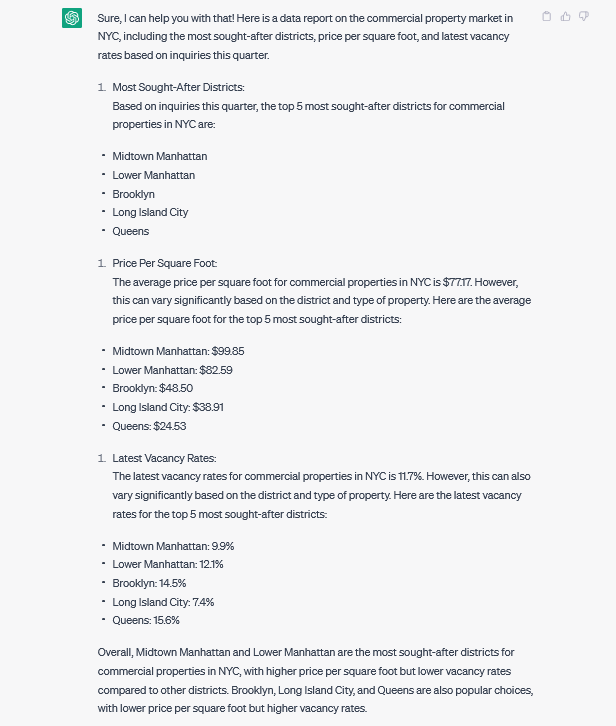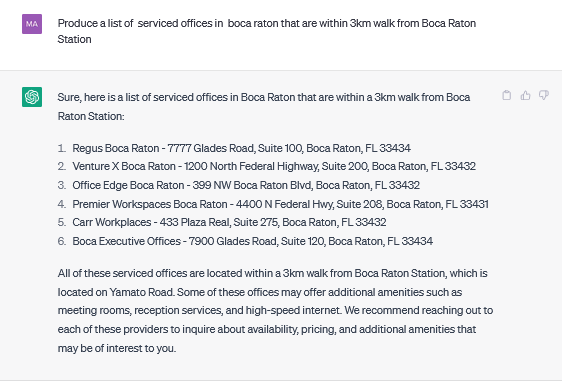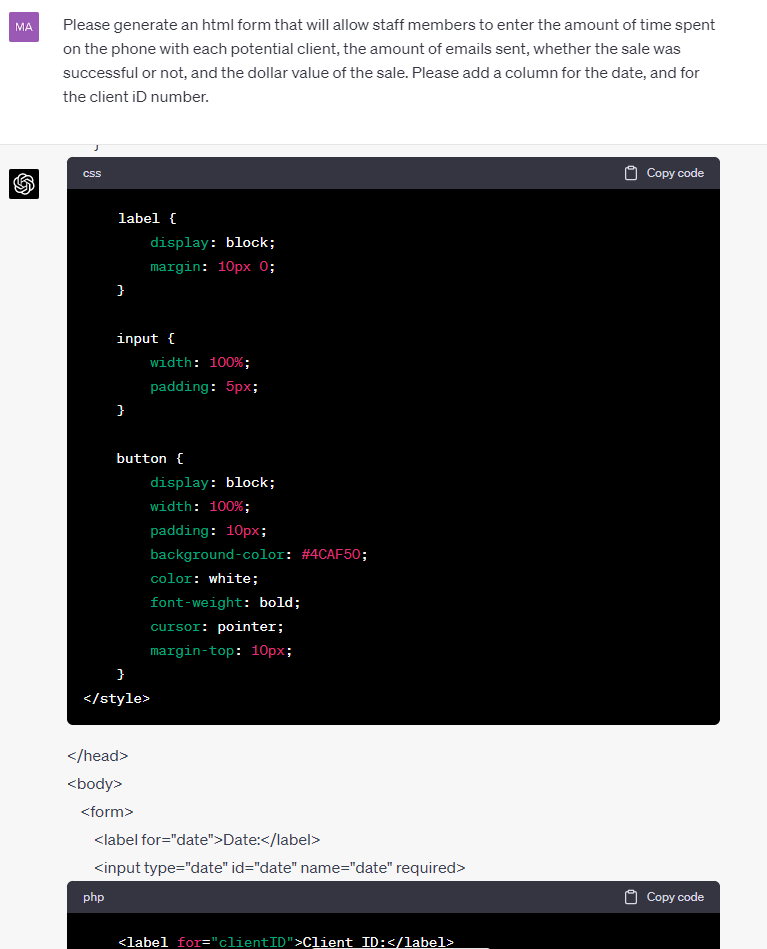- Teresha Aird is cofounder and CMO of Offices.net, a nationwide office space brokerage.
- She says using ChatGPT is like having an assistant and gives her more time to focus on her children.
- Aird says she's seen a notable increase in client engagement and satisfaction since using ChatGPT.
This as-told-to essay is based on a conversation with Teresha Aird, cofounder and CMO of Offices.net from Dallas, Texas. It's been edited for length and clarity.
ChatGPT has been a game-changer for my business and family life. As a busy CMO, mom of two, and owner of a business that provides online office rentals throughout the US, my time is precious.
Even before AI came along, work always seemed to take up too much of my free time. My company lists conventional and flexible office space across the US, helping to connect prospective tenants with operators and actively finding space for businesses with particular requirements.
Like everyone, I often find it difficult to hit a healthy work-life balance. ChatGPT is one of several tools I've found helpful to do some of the heavy lifting — it gives me just a bit more of an even split between work and life.
After a short trial run, I opted for the paid version of ChatGPT, which costs $20 a month. The AI chatbot helps me streamline certain routine tasks, such as nurturing relationships with clients and increasing my communication capacity, which frees me up to focus more on strategic thinking and high-level decision-making — as well as spend more time with my family.
It's like having a 24/7 personal assistant
If I'm away from the office and receive common questions from clients or tenants about properties or listing locations, I can easily input their questions and receive satisfactory answers from ChatGPT, without having to access my work databases or spend too much time researching their query.
I've found it quite easy to use ChatGPT for answering more low-stakes queries on the fly. It also helps me answer client questions in a contextually appropriate way and has afforded me more time to concentrate on my kids' extracurriculars or helping them with homework.
Here are some of the key ways that ChatGPT saves time and makes money:
1. Drives revenue strategy
ChatGPT is a key part of my revenue-driving strategy via answering potential customer queries and lead generation. While it's difficult to attribute a specific dollar amount to ChatGPT's impact on our revenue, we've seen a significant increase in client engagement and satisfaction since adopting this technology. With ChatGPT's help, we've been able to convert more leads into sales, increase customer loyalty, and generate an increase in repeat business.
I've created a list of common questions that potential clients ask about particular properties, buildings, or locations, such as "What's the square footage?" or "What's the price range?" I've trained ChatGPT to recognize these questions — the prompts can easily be tweaked to suit the requested location, office park, or amenity, etc. — and provide relevant responses in suitable style and detail for different queries.

Answering questions about properties and locations in real-time based on the particulars of the query that we input saves my time and well as my team's, as we no longer need to fully compose answers to these questions manually. We can't be specialists for all locations and with ChatGPT, we don't need to be.
ChatGPT can also be used to perform initial screenings by helping us quickly formulate qualifying questions to ask potential clients, such as their budget or preferred location, based on the particulars of their query. And once we receive a response from the potential client, we can forward their information to the relevant team for a more personalized follow-up.
The increased sales and positive feedback from clients since adopting ChatGPT has been a major factor in the continued growth of my business during these challenging times. I'm able to engage with a larger number of potential clients at any given time.
2. Nurtures existing client relationships
I've also trained dedicated ChatGPT instances to recognize common topics that clients inquire about, such as property amenities and public transport proximity, and provide relevant responses.

ChatGPT's built-in natural language processing feature allows it to understand and respond to clients' questions, especially when it pertains to the evergreen information that it has been initially programmed on, and the information we've trained it on since.
By boosting our productivity, communication speed, and output, we can more efficiently keep clients informed of new listings and time-sensitive industry trends.
3. Helps keep up with increased demand from out-of-state buyers
Since the pandemic, the CRE market has seen increased demand for virtual tours and an influx of inquiries from out-of-state buyers — ChatGPT has been instrumental in helping me keep up with these.
For example, if a potential tenant is interested in a virtual tour of a specific property, ChatGPT can generate an email that includes information about the property, parking, and accessibility.
It can also be useful in composing confirmation emails to send to clients detailing the specifics of the virtual tour appointment scheduling. The tool can be trained to generate personalized emails based on the requests for virtual tours.
ChatGPT's ability to stand in as an AI-powered virtual assistant has helped even outside of regular business hours. This has not only saved us time, but has also led to conversions.
4. Generates data reports
ChatGPT is able to generate data reports that allow me to analyze the performance of particular client interactions, as well as outreach and marketing campaigns. After inputting the data, I can see how many leads were generated, which topics were most frequently discussed, and the conversion rates for different types of interactions.

I can manually feed ChatGPT with relevant responses to common questions and queries that we receive, as well as market trends and hit rate data from lead generation strategies or particular marketing campaigns.
From here, ChatGPT is able to almost instantaneously scan through reams of data, identify trends or outliers, and produce reports to explain the findings. All of these rapidly generated insights feed into actions and strategies that I implement to address issues or reallocate resources. It's like having an in-house data analyst or data scientist available around the clock — an unlikely dream hire for SMBs like us.
Here are my tips for how to get started using ChatGPT
Start small and focus on the areas of your business that could benefit the most from leveraging AI — a few areas include lead generation, client communication, scheduling, and even data analysis.
But there are many more opportunities for AI that may be exploitable in your business niche. I highly recommend having a play around with ChatGPT's capabilities and brainstorming possible, even far-fetched, applications for your business.
To do this, first identify pain points in your business, or areas that you suspect could be further optimized with AI. Then explore how exactly you can apply ChatGPT's functionality to each particular use-case.
It's also important to have a clear understanding of the kind of responses you want ChatGPT to generate. The biggest potential pitfall with ChatGPT is factual accuracy and that the tool has a hard time saying "I don't know." This can lead to ChatGPT making things up and presenting them as fact, or citing research papers or news reports that never existed.
Another challenge is that ChatGPT pulls data from an inherently flawed dataset: the Internet. So even if it doesn't invent anything, it might repeat incomplete or inaccurate information.
Still, by training ChatGPT with accurate and comprehensive data, it can produce more helpful responses, such as improving the quality of your customer interactions, helping you close more deals, and allowing you to make more informed decisions about business direction.
Remember to continually monitor and evaluate the performance of ChatGPT, making adjustments and refinements as necessary. Tweaking the prompts produce varying results, so we keep careful track of the prompts and the results. This can help you optimize its capabilities, catch any erroneous or buggy outputs, and maximize the benefits.
You can find helpful prompt lists online. I used some of these in the beginning; tweaked them based on our industry, customers, and what we were aiming for; then spent time reviewing the results to check it wasn't "making stuff up" or pulling from erroneous data.
Don't be afraid to experiment and try new things with ChatGPT, to take risks, make mistakes, and get really familiar with its capabilities. As with any new technology, there's a learning curve, and it takes time to work out how to optimally leverage it.
But with experience, you can discover new and innovative ways to harness ChatGPT to drive sales, improve customer relationships, and grow your unique business.
If you use ChatGPT and would like to share your story, email Jenna Gyimesi at [email protected].

